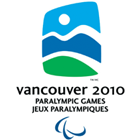Paralympic Winter Games Medals Unveiled in Vancouver
Dramatic form of the Vancouver 2010 medals is inspired by the ocean waves, drifting snow and mountainous landscape 16 Oct 2009 By IPCAs unique as the world's top athletes and their awe-inspiring performances, every medal won at the Vancouver 2010 Olympic and Paralympic Winter Games will be a one-of-a-kind work of art. The medals, revealed today, each feature a different crop of larger contemporary Aboriginal artworks and are undulating rather than flat - both firsts in Games history.
The dramatic form of the Vancouver 2010 medals is inspired by the ocean waves, drifting snow and mountainous landscape found in the Games region and throughout Canada. The Olympic medals are circular in shape, while the Paralympic medals are a superellipse, or squared circle. Both are equal in size. Their significant weight - between 500g to 576g depending on the medal - represents the magnitude of the athlete’s accomplishment. The Olympic medals are 100mm in diameter and about six mm thick, while the Paralympic medals are 95mm wide and about six mm thick. They are among the heaviest medals in Olympic and Paralympic history.
The gold, silver and bronze medals were designed with direct input from Olympic and Paralympic athletes who shared their experiences about medals they won at past Games and what they would like to see in future medals. Their stories and dreams helped shape the medals, which are being produced and supplied by Vancouver 2010 Official Supporters the Royal Canadian Mint and Canadian mining and metals giant Teck Resources Limited, in collaboration with the Vancouver Organizing Committee for the 2010 Olympic and Paralympic Winter Games (VANOC).
Daniel Wesley, a five-time Paralympian and 12-time medallist for Canada in Alpine Skiing and Wheelchair Racing at the Summer and Winter Games, agreed. "Every one of my medals has meaning and motivation because of the memories attached to them and the people I’ve been able to share them with, from family and friends to the crowds in the stadiums on those days. The 2010 Paralympic medals - and the care taken by the design team to ensure they’re equal in size to the Olympic medals yet still unique in their artwork and shape - demonstrates to me, the public and other Paralympians how greatly our accomplishments and stories are valued."
The medals are based on two large master artworks of an orca whale (Olympic) and raven (Paralympic) by Corrine Hunt, a Canadian designer/artist of Komoyue and Tlingit heritage based in Vancouver. Each of the medals has a unique hand-cropped section of the abstract art, making every medal one-of-a-kind.
For example, each medal will include its own signature elements of the orca and raven artwork, such as the suggestion of the orca’s eye, the curve of its dorsal fin, or perhaps the contours of the raven’s wing. A silk scarf printed with the master artwork will be presented to each Olympian or Paralympian with their medal enabling them to see how their medal connects with those awarded to other athletes at the Games to make the whole design.
Internationally renowned Canadian industrial designer and architect Omer Arbel, also of Vancouver, used his extensive knowledge of materials and fabrication processes to create the innovative undulating design of the medals, which are struck nine times each to achieve the distinctive look as part of the 30-step medal fabrication process. The Organizing Committee asked Hunt and Arbel to join their creative talents together on the medals project after they submitted separate designs proposals that both contained compelling elements. VANOC received 48 medal design ideas from across Canada and internationally after issuing a request for proposals in December 2007.
"The Vancouver 2010 team has outdone itself in the design of the Vancouver 2010 Paralympic Winter Games’ medals," said Sir Philip Craven, president of the International Paralympic Committee (IPC). "The choice of the raven as the artwork is especially important to us because it symbolizes the powers of transformation and determination - qualities every Paralympian embodies on and off the field of play. No doubt the beauty of these medals will spur them even higher as they strive to reach their dreams and triumph against adversity yet again in 2010."
The strong black wings and proud beaked profile of the raven appear in a three-part composition in the style of a totem pole. The bird, species of which can be found around the globe, is often associated with transformation and healing abilities and represents determination, creativity and wisdom.
The full descriptions explaining the design and artwork, as found in the materials presented to the athletes with their medals, are available at www.vancouver2010.com.
The Royal Canadian Mint will produce 615 Olympic and 399 Paralympic medals at their headquarters in Ottawa for the 2010 Winter Games. They started striking the medals in July 2009 and will finish the historic task in November. The Mint also manufactured the medals for the Montreal 1976 Olympic Games.
Teck Resources, a Vancouver-based diversified metals company, is supplying the metals used in the production of the Olympic and Paralympic medals. The metals are from Teck’s operations in Canada, including British Columbia, Ontario and Newfoundland and Labrador, as well as Alaska, Chile and Peru.
For more information on the medals for the Vancouver 2010 Olympic and Paralympic Winter Games, visit www.vancouver2010.com.

 Facebook
Facebook
 Instagram
Instagram
 Twitter
Twitter
 Youtube
Youtube
 TikTok
TikTok
 Newsletter Subscribe
Newsletter Subscribe




